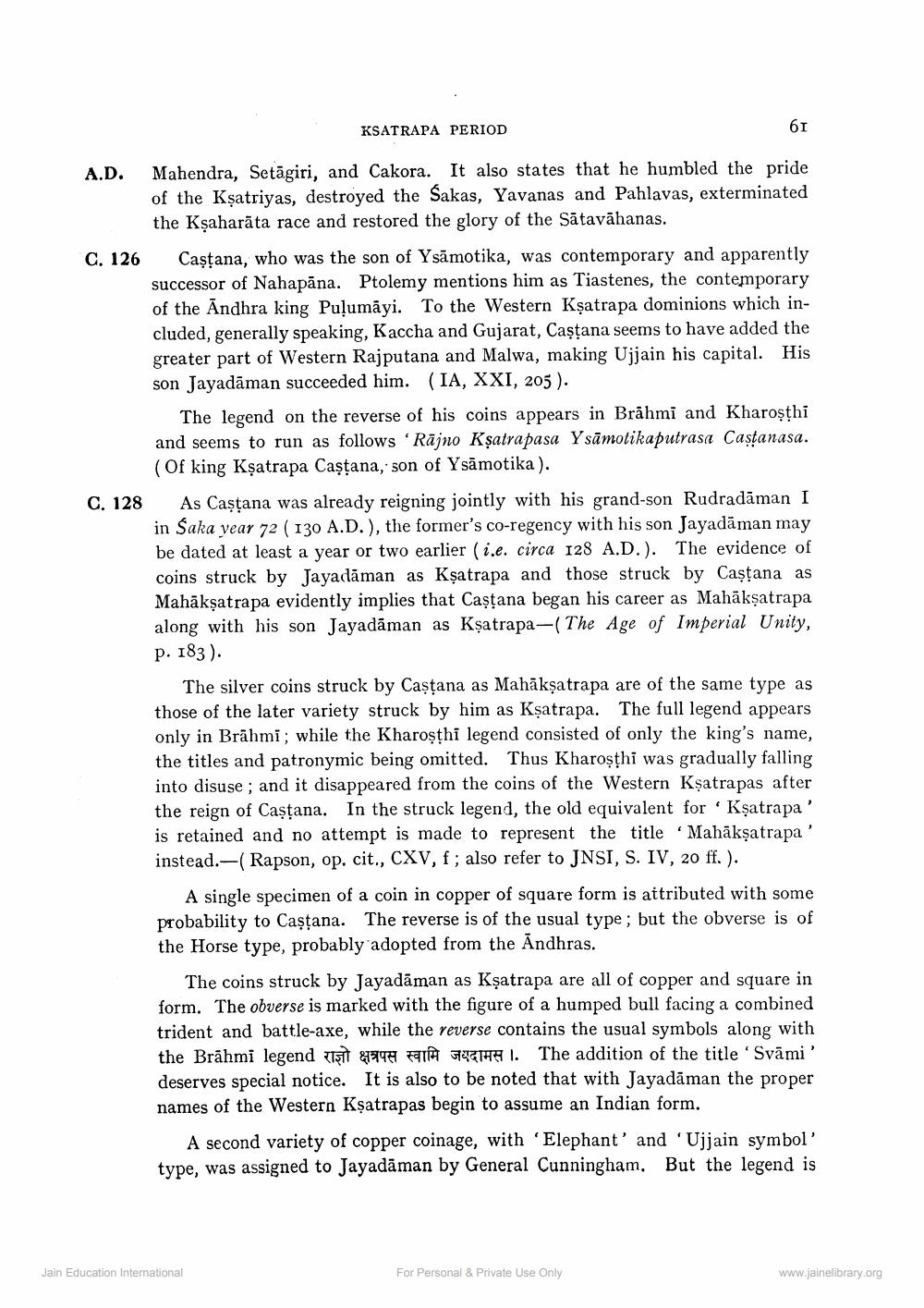________________
KSATRAPA PERIOD
61
A.D.
C. 126
C. 128
Mahendra, Setāgiri, and Cakora. It also states that he humbled the pride of the Ksatriyas, destroyed the Sakas, Yavanas and Pahlavas, exterminated the Kşaharāta race and restored the glory of the Sātavāhanas.
Caştana, who was the son of Ysāmotika, was contemporary and apparently successor of Nahapāna. Ptolemy mentions him as Tiastenes, the contemporary of the Andhra king Puļumāyi. To the Western Kșatrapa dominions which included, generally speaking, Kaccha and Gujarat, Caştana seems to have added the greater part of Western Rajputana and Malwa, making Ujjain his capital. His son Jayadāman succeeded him. (IA, XXI, 205).
The legend on the reverse of his coins appears in Brāhmi and Kharoşthi and seems to run as follows 'Rājno Ksatrapasa Ysāmotikaputrasa Castanasa. (Of king Kșatrapa Caştana,' son of Ysāmotika).
As Caştana was already reigning jointly with his grand-son Rudradāman I in Saka year 72 (130 A.D.), the former's co-regency with his son Jayadāman may be dated at least a year or two earlier (i.e. circa 128 A.D.). The evidence of coins struck by Jayadāman as Ksatrapa and those struck by Castana as Mahākşatrapa evidently implies that Castana began his career as Mahākṣatrapa along with his son Jayadāman as Ksatrapa-( The Age of Imperial Unity, p. 183).
The silver coins struck by Caştana as Mahākṣatrapa are of the same type as those of the later variety struck by him as Kșatrapa. The full legend appears only in Brāhmi; while the Kharoşthi legend consisted of only the king's name, the titles and patronymic being omitted. Thus Kharoşthi was gradually falling into disuse, and it disappeared from the coins of the Western Kşatrapas after the reign of Caştana. In the struck legend, the old equivalent for Kşatrapa' is retained and no attempt is made to represent the title Mahākşatrapa' instead.-(Rapson, op. cit., CXV, f; also refer to JNSI, S. IV, 20 ff.).
A single specimen of a coin in copper of square form is attributed with some probability to Caştana. The reverse is of the usual type; but the obverse is of the Horse type, probably adopted from the Andhras.
The coins struck by Jayadāman as Kşatrapa are all of copper and square in form. The obverse is marked with the figure of a humped bull facing a combined trident and battle-axe, while the reverse contains the usual symbols along with the Brāhmi legend 1517 4794 Fah FT14H I. The addition of the title 'Svāmi' deserves special notice. It is also to be noted that with Jayadāman the proper names of the Western Kşatrapas begin to assume an Indian form.
A second variety of copper coinage, with Elephant' and 'Ujjain symbol' type, was assigned to Jayadāman by General Cunningham. But the legend is
Jain Education Interational
For Personal & Private Use Only
www.jainelibrary.org




